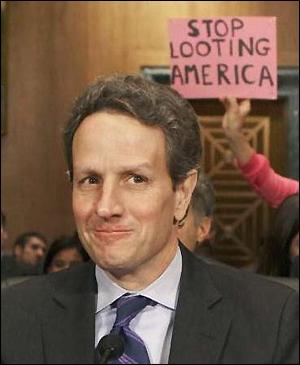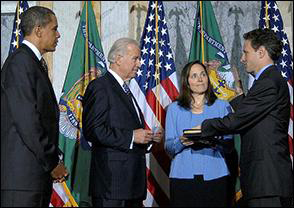By Pam Martens: May 12, 2014

The Non Profit Organization, Code Pink, Appeared on Multiple Occasions Holding Protest Signs Behind Geithner as he Appeared Before Congress to Explain the Massive Bailouts of the Banks
Tim Geithner, former head of the New York Fed during the lead up to the Wall Street melt down, then Secretary of the Treasury in President Obama’s first term, is undergoing his own version of a big bank stress test: does he have the capital to survive the storm he has stirred up with his new, revisionist history book, Stress Test: Reflections on Financial Crises.
Geithner’s book has barely made it to the bookstore shelves (it’s slated for official release today) and already he’s been called a liar by R. Glenn Hubbard, Dean of the Columbia Business School; Geithner is effectively calling author Ron Suskind a liar in the book; and the book’s attack on Neil Barofsky, former Special Inspector General of the Troubled Asset Relief Program (TARP) has warranted a strong response from Barofsky where he says he doesn’t believe former Treasury Secretary Hank Paulson made the remarks that Geithner has attributed to him against Barofsky.
Politico’s MJ Lee explains the ruckus between Hubbard and Geithner. Hubbard was the head of the Council of Economic Advisers during the presidency of George W. Bush and advisor to Mitt Romney during his 2012 campaign. Geithner says in the book that Hubbard told him “Well, of course we have to raise taxes — we just can’t say that now.” Hubbard told Politico this statement “just happens to be a lie.”
Geithner’s looming dispute with Ron Suskind stems from Confidence Men, a book by Suskind published in 2011. The book portrays Geithner as ignoring a directive from President Obama to wind down the teetering behemoth, Citigroup. Instead, Geithner approved the massive bailout package to the insolvent company. In Stress Test, Geithner says no such order ever came from the President, writing that the President “never told me to pursue that path.”
To determine just who is telling the truth in the Suskind-Geithner version of the Citigroup saga, our previous review of Geithner’s appointment calendars for 2007 and 2008 when he was Citigroup’s regulator at the New York Fed might prove instructive. During 2007 and 2008, as Citigroup entered a death spiral resulting from a decade of obscene executive pay, off balance sheet debt, toxic assets and mismanagement, Geithner hobnobbed with Citigroup executives, holding 29 breakfasts, lunches, dinners and other meetings, including one very odd luncheon with Citigroup’s former Chairman and CEO, Sandy Weill. As we previously reported:
“On January 25, 2007, Geithner not only hosted Weill to lunch at the New York Fed, but Geithner brought his teenage daughter to the lunch. Geithner’s appointment calendar shows Elise Geithner, his daughter, sharing his chauffeured car to work with her father and then joining him at lunch with Sandy Weill. In case you’re wondering, Take Your Daughters and Sons to Work Day was April 26 that year, not the day of this luncheon. A few months later, on May 17, 2007, Geithner joined Weill for breakfast at the expensive Four Seasons.”
Jo Becker and Gretchen Morgenson wrote in an article for the New York Times on April 26, 2009 that Geithner has admitted that Sandy Weill spoke with him about becoming Citigroup’s CEO after Chuck Prince resigned following multi-billion dollar losses in late 2007.
Geithner’s animosity toward Barofsky likely stems from Barofsky’s portrait of Geithner in Bailout: How Washington Abandoned Main Street While Rescuing Wall Street, the book by Barofsky that was released in 2012.
During the financial crisis, Barofsky was the Special Inspector General of TARP, one of the key bank bailout programs. His official job was to monitor how the hundreds of billions of taxpayer dollars were spent.
According to Barofsky, the Home Affordable Modification Program (HAMP) did not have a goal of keeping struggling families and children in their homes. It’s real goal, according to U.S. Treasury Secretary Tim Geithner, was to “foam the runway” for the banks.
Barofsky explains as follows in his book:
“For a good chunk of our allotted meeting time, Elizabeth Warren grilled Geithner about HAMP, barraging him with questions about how the program was going to start helping home owners. In defense of the program, Geithner finally blurted out, ‘We estimate that they can handle ten million foreclosures, over time,’ referring to the banks. ‘This program will help foam the runway for them.’
“A lightbulb went on for me. Elizabeth had been challenging Geithner on how the program was going to help home owners, and he had responded by citing how it would help the banks. Geithner apparently looked at HAMP as an aid to the banks, keeping the full flush of foreclosures from hitting the financial system all at the same time. Though they could handle up to ‘10 million foreclosures’ over time, any more than that, or if the foreclosures were too concentrated, and the losses that the banks might suffer on their first and second mortgages could push them into insolvency, requiring yet another round of TARP bailouts. So HAMP would ‘foam the runway’ by stretching out the foreclosures, giving the banks more time to absorb losses while the other parts of the bailouts juiced bank profits that could then fill the capital holes created by housing losses.”
The evidence that this is exactly what the plan was is buttressed by the thousands of homeowners who have reported that modifications were promised, they had completed the paperwork, months or even years went by, then with no warning they were foreclosed on by their bank. They were the foam under the landing gear of a hijacked plane and a lunatic control tower.
In this fascinating interview today with Susan Page at USA Today, Geithner actually uses the plane analogy, but his image of himself is something like that of Indiana Jones, hero to the rescue, defying all odds:
“It’s like you’re in the cockpit and the plane’s on fire and smoke is filling the cabin. And you’ve got a bunch of people on the plane — you’ve got some terrorists, or you’ve got some people who built the plane or didn’t design the fire system right — and people want you to come out of the cockpit and put them in handcuffs or beat them up. And it’s understandable, but you’ve got to land the plane safely if you want to protect people from the risk of catastrophe.”
The interesting thing about those Wall Street big-bank “terrorists” and the regulators who “didn’t design the fire system right” is that they’ve gained more power and ability to bankrupt the nation since the flaming aircraft landed on the runway foamed with the human suffering of evicted families who were robo-signed out of their homes.
Just last Wednesday, Thomas Hoenig, Vice Chairman of the Federal Deposit Insurance Corporation, reported that “the average notional value of derivatives for the three largest U.S. banking firms at year-end 2013 exceeded $60 trillion, a 30 percent increase over their level at the start of the crisis” and that the largest Wall Street banks are “excessively leveraged with ratios, on average, of nearly 22 to 1.”
When President Obama nominated former Citigroup executive, Jack Lew, to succeed Geithner as Treasury Secretary, the President said: “When the history books are written, Tim Geithner is going to go down as one of our finest secretaries of the Treasury.”
President Obama must have been contemplating Geithner’s own revisionist history book and the mega Wall Street-styled road show planned to instill this revisionist history as the accepted wisdom of the age.
The Geithner road show includes a “town hall” and events featuring former Fed Chairman Ben Bernanke, former Treasury Secretary Hank Paulson, an event at Harvard with David Gergen and various other moderated events.
Given that the raging debate today is just how badly the financial markets are rigged by these same untamed Wall Street behemoths, Geithner’s book will hopefully be relegated quickly to the discount rack while he moves on to collect his winnings on Wall Street in his new job as President of private equity firm, Warburg Pincus.


